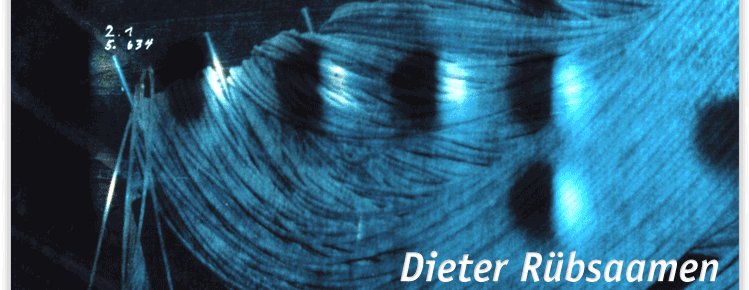The world exists because we see it. We are linked to it through our perception. We see, for example, how we touch things and thus take ourselves as part of the world. An elementary demand characterising our relationship with the world states that things, which are visible, also exist.
Considering that the visible demands reality and truth, doubts instantly occur: the visible might not be all, it might hide the opposite, the bigger or the illusion, the never-ending stretches out in the invisible, facts only represent a possibility of reality, and reality might not be binding and the same for everybody, rather a mere number of subjective views.
Dieter Rübsaamen discusses with the unknown of the world, he investigates at the borders of the visible and beyond, and he wants to get closer to reality even where it disappears. He wants to listen to the invisible and turn it into an image. His work is as manifold and open as the issue being examined. Changing perspectives produce various truths. Things are not static. Rübsaamen’s work is thus floating around in an unlockable process.
Most various materials are used: civilizing relicts, protocols, blueprints, diagrams, things which once had a specific meaning and are now handled by Rübsaamen in a different way. He addresses art, literature, philosophy, natural and human sciences as well as information technology to get their proposals. He uses language as system of symbols and marks its borders. He works with the painting because the pictographic thinking also leads to cognition. He approaches his work from different perspectives. Rübsaamen intends to surmount the descriptive through the descripitive. His art shall visualise those feelings and thoughts while the unconscious determines the reality and its perception.
Thus, he follows the principles of a researcher with the same demand for accuracy and knowledge. He undertakes extensive work in the field of natural sciences being challenged to find languages, models and symbols to illustrate the invisible. With regard to the group of works present here, he overlaid – amongst other things – photos he had taken at CERN, the European Organization for Nuclear Research. Research on the smallest material elements is carried out there and in a quest to uncover the rules of the universe and this source of inspiration opens up areas that are increasingly disconnected from the picture-oriented power of imagination. Growing knowledge apparently goes hand-in-hand with the growing unknown. Dieter Rübsaamen embraces this openness and uncertainty and thus gains the productive energy for his art.
On the occasion of the artist’s 70th anniversary, the Künstlerforum Bonn presents in cooperation with the Kunstmuseum Bonn a comprehensive exhibition comprising works from the early fifties to the present. Curated mainly by the artist, it is an authentic retrospective of, and outlook on, a manifold work which continuously restarts and, in integrating all possibilities, keeps on searching.
Volker Adolphs
Translated by André Müller and revised by Ciaran Morrisey

